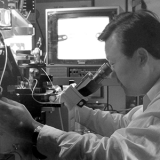Glaucoma is a leading cause of irreversible blindness worldwide, with an estimated 80 million people predicted to be affected by 2020.
Last month the Australian Government committed to strengthening Australians’ health through a $440 million commitment for research to prevent illness and deliver better care.
Professor Dao-Yi Yu received more than $2 million through the National Health and Medical Research Council (NHMRC) to further advance glaucoma therapy research.
Professor Yu, a leading Australian ophthalmologist, led the development of a new surgical treatment of glaucoma that has since been used on more than 75,000 patients worldwide.
'While this new surgical technique has proven to be less invasive, safer, and has a shorter recovery time, we propose to introduce new techniques and knowledge to further improve the clinical outcomes but also investigate a completely new approach to glaucoma surgery,' said Professor Yu.
According to the International Agency for the Prevention of Blindness, glaucoma is a leading cause of irreversible blindness worldwide, with an estimated 80 million people affected worldwide#. Raised intraocular pressure (IOP) is the dominant risk factor in glaucoma and most therapy is aimed at reducing IOP.
Glaucoma filtration surgery is the most effective surgical treatment for glaucoma. However, there is currently no procedure that is free from sight-threatening complications.
Professor Yu leads a multidisciplinary team to improve outcomes for individuals with glaucoma.
'The current therapy is based on the surgical implantation of a bioengineered drainage tube (microfistula) to drain excess fluid from the eye and reduce IOP,' explained Professor Yu.
Professor Yu’s previous studies have shown that the lymphatic vessels in the conjunctiva are key to a successful surgical outcome.
The next step is to develop new non-invasive imaging techniques that can visualise the conjunctival lymphatics to allow the surgeon to place a drainage tube in a location with the healthiest lymphatic vessels.
Professor Yu also proposes to develop a new method of lowering IOP that will avoid the common issues with conjunctival scarring and lymphatic performance.
'This will provide significant benefits to glaucoma patients worldwide in terms of improved surgical outcomes and lessen the need for a second surgical intervention,' said Professor Yu.
Over the next five years, Professor Yu and his team hope to develop a device for the non-invasive imaging of conjunctival lymphatics that will be used to guide the surgeon as to the optimum implantation site for the drainage tube.
Professor Yu’s team will also investigate the feasibility of modulating conjunctival lymphatic function with eye drops to better regulate the drainage rate and the resultant IOP.
'The success of the microfistula project is based on more than 20 years of research, funded predominantly from NHMRC Program, Project, and Development Grants. The translation of laboratory based research through to clinical trials and commercial development is often a long process but the benefits to patients are significant,' said Professor Yu.
A full list of grant recipients is available at Outcomes of funding.
# http://www.iapb.org/knowledge/what-is-avoidable-blindness/glaucoma/
